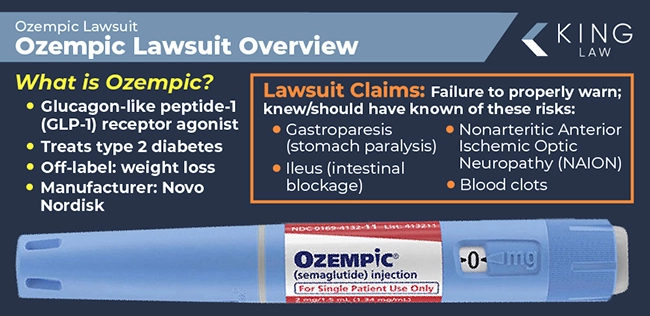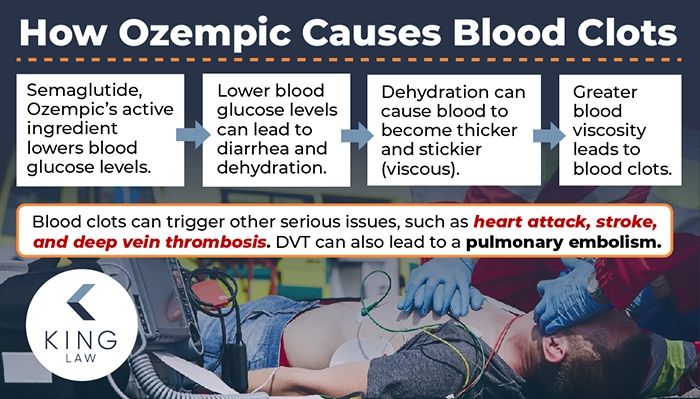
People are filing Ozempic lawsuits alleging the semaglutide drug caused a specific type of blood clot called a deep vein thrombosis (DVT). DVT can lead to severe complications, including pulmonary embolisms (PEs). PEs cause permanent lung/organ damage or death. The lawsuits claim Ozempic’s manufacturer, Novo Nordisk, failed to adequately warn people about dangerous complications. Lawsuits against Novo Nordisk are being filed as more people experience these blood clots after taking Ozempic.
About the Ozempic Blood Clot Lawsuit:
Ozempic Blood Clots and Lawsuit Overview
Research Links Ozempic to Increased Risk of Blood Clots
Ozempic Side Effects: Blood Clots, DVTs, and Pulmonary Embolisms
How Does Ozempic Cause Blood Clots?
How Common Are Blood Clots Among Ozempic Users?
Can Ozempic Cause Blood Clots in Legs?
Deep Vein Thrombosis (DVT) vs Pulmonary Embolism (PE)
Other Semaglutide Drugs Linked to Blood Clots
Eligibility Criteria to File an Ozempic Blood Clot Lawsuit
How to File an Ozempic Blood Clot Lawsuit
Ozempic Blood Clot Settlement and Payout Amounts
Have You Experienced Blood Clots While Taking Ozempic?
Ozempic Blood Clots and Lawsuit Overview
The popular diabetes and weight-loss drug Ozempic is associated with numerous negative side effects. Patients and doctors are now exploring the connection between Ozempic and blood clots. People are filing lawsuits claiming Ozempic caused a type of blood clot called deep vein thrombosis (DVT). DVT can lead to a potentially fatal condition called a pulmonary embolism (PE).
Ozempic belongs to a class of drugs called Glucagon-like peptide-1 (GLP-1) receptor agonists. GLP-1 agonists are also known as GLP-1 receptor agonists. Drugs in this class are usually used to treat type 2 diabetes and obesity. GLP-1 drugs lower blood glucose levels and alter a patient’s metabolism. Ozempic is a semaglutide drug, like Wegovy and Rybelsus. Other types of GLP-1 agonists include dulaglutide (Trulicity), liraglutide (Saxenda), and tirzepatide (Zepbound and Mounjaro), whose manufacturers are also facing lawsuits.

Ozempic Lawsuit Background
Ozempic lawsuits claim that Novo Nordisk, Ozempic’s manufacturer, failed to warn patients of the possibility of developing DVT or PE after taking the drug. Ozempic’s prescribing information does not list blood clots or DVT as potential side effects. This leaves many patients unaware of how taking Ozempic could lead to these dangerous medical conditions.
This is part of a pattern for the drug manufacturer. The original Ozempic prescribing information (warning label) did not include severe gastrointestinal side effects (gastroparesis) or permanent vision loss. The current warning label includes some information about these gastric and vision side effects. However, lawsuits allege these warnings do not include enough information to properly warn patients of potentially dangerous and life-altering side effects.
People are filing lawsuits against Novo Nordisk alleging it omits or improperly represents side effect information on Ozempic’s warning label. Many of these lawsuits claim the company knew about these potential side effects and did not warn patients or medical professionals. Patients who experience DVT or PE often have lasting health consequences or do not survive. Other patients are filing lawsuits for other harms resulting from Ozempic.
If you or a loved one experienced blood clots, DVT, or PE after taking Ozempic, you may be entitled to legal compensation. This compensation is intended to help with the long-term mental and physical side effects of being harmed by a drug that was supposed to help you. One of our experienced attorneys can discuss your options for filing a lawsuit.
Research Links Ozempic to Increased Risk of Blood Clots
The medical community has been exploring how Ozempic may cause blood clots in people who take the drug for diabetes or weight loss. A 2021 data analysis published in the Endocrine Journal explored serial trial outcomes for patients taking semaglutide drugs to treat their type 2 diabetes.
The study, titled, “Comprehensive analysis of the safety of semaglutide in type 2 diabetes: a meta-analysis of the SUSTAIN and PIONEER trials,” analyzed data about side effects people experienced after taking semaglutide drugs, such as Ozempic. The meta-analysis included 21 trials (10 PIONEER and 11 SUSTAIN trials) involving 12,260 semaglutide users. The data showed a 266% increase of blood clots and DVT in people taking semaglutide drugs.
This objective of the meta-analysis was to understand how frequently patients had serious adverse events (SAEs) after taking semaglutide. Blood clots were one of the SAEs analyzed. Although the dataset did not include data on PEs, DVT is the most common cause of lung embolisms. This means that many people who experienced DVTs as a result of taking Ozempic were at risk for PE.
The authors of the analysis, Dao-Gen Yin, Liang-Liang Ding, Hai-Rong Zhou, Mei Qiu, and Xue-Yan Duan, also explored why this complication might happen. One of the hypotheses documented in the study examines the link between diarrhea, dehydration, and DVT. Dehydration and diarrhea increase with semaglutide use. Dehydration leads to an increase in blood viscosity (stickiness). This increase in viscosity can lead to blood clots. The authors of the analysis also recommended exploring if the weight loss that occurs on semaglutide drugs may contribute to the formation of blood clots.
Although many people who take semaglutide drugs have minimal or mild side effects, dangerous side effects do occur in some users. The analysis concluded that doctors should be monitoring people who are taking semaglutide drugs, like Ozempic, for symptoms of blood clots. Patients and doctors should be extra vigilant if the patient has other risk factors for blood clots.
Ozempic Side Effects: Blood Clots, DVTs, and Pulmonary Embolisms
The meta-analysis published in the Endocrine Journal found a 266% increased risk of developing a specific type of blood clot called a DVT. DVT occurs when a clot, called a thrombus, occurs in one of the deep veins in the body, usually in the leg. This clot may not cause symptoms or it may cause pain, swelling, and irritation. Besides often being painful, DVT can lead to a serious medical condition called a pulmonary embolism (PE).
DVT can cause a PE. This occurs when the clot or part of the clot breaks free from the vein and enters the bloodstream. Once in the bloodstream, the clot can enter the lung and cause a sudden blockage in a lung artery. This blockage can lead to:
- Permanent damage to the lung
- Low blood oxygen levels
- Damage to other organs due to low oxygen levels
- Death
The precise mechanism (cause) of how Ozempic and semaglutide drugs lead to DVT is still being studied. However, people taking Ozempic should watch for the following symptoms of blood clots:
- Recurring pain or discomfort in one area of the body
- Redness or tenderness in the affected area
- Unexplained pain in the arms, legs, or other parts of the body
People taking Ozempic should also closely monitor themselves for the potentially serious symptoms of DVT and PE:
- Deep vein thrombosis (DVT): Swelling, pain, and tenderness in the affected area, often the leg
- Pulmonary embolism (PE): Sudden shortness of breath, chest pain, sweating, and rapid heart rate
How Does Ozempic Cause Blood Clots?
Scientists and medical professionals are still exploring how Ozempic may lead to blood clots and DVT. Ozempic’s active ingredient is semaglutide which is called a GLP-1 agonist, which can help people control blood glucose levels. These drugs can help people control their type 2 diabetes or lose weight, but the drugs also have many potential side effects.
Two of those side effects are diarrhea and the associated dehydration. When people are dehydrated by extended diarrhea, their blood can become thicker and stickier (viscous). People who have greater blood viscosity are at a higher risk of blood clots, including DVT. Blood clots can lead to DVT, heart attacks, or strokes.
The meta-analysis of the PIONEER and SUSTAIN trials stated, “diarrhoea or dehydration can lead to the increase in blood viscosity, semaglutide increases the risk of deep vein thrombosis possibly due to increasing that of diarrhoea.” Similarly, the authors said more research is needed on whether the weight loss often experienced while taking semaglutide drugs may increase the risk of DVT, stating, “Moreover, whether an increase in deep vein thrombosis is related to a decrease in body weight also needs to be further investigated.”
People who are taking Ozempic may have patient-specific risk factors that increase the likelihood of developing blood clots. Pre-existing conditions such as obesity, cardiovascular disease, and clotting disorders can put patients taking Ozempic at a higher risk of developing blood clots.
The connection between blood clots, DVT, and PE while taking semaglutide drugs will be further examined by the medical community. People taking this drug should talk to their doctors about potentially serious side effects and be monitored for symptoms.

How Common Are Blood Clots Among Ozempic Users?
More data is needed to understand what percentage of Ozempic users experience blood clots, DVT, or PE. However, The meta-analysis of the SUSTAIN AND PIONEER serial trials found a 266% increased risk of people developing DVT while taking a semaglutide drug, like Ozempic. This study reviewed data for more than 26,000 participants, more than 12,000 of which were taking semaglutide drugs, including Ozempic. The patients taking semaglutide drugs were about 3.5 times more likely to develop DVT than similar people who weren’t.
Patients who have pre-existing conditions that put them at a greater risk for developing blood clots should speak with their doctors about taking semaglutide drugs.
Can Ozempic Cause Blood Clots in Legs?
Patients taking semaglutide drugs, like Ozempic, may experience blood clots in their legs. The study of the PIONEER and SUSTAIN trials found people who took semaglutide drugs had a 3.66 times higher risk of DVT. DVT is a type of blood clot that usually forms in the leg. This means that people taking Ozempic may develop blood clots as a result of taking the drug.
When patients take Ozempic, they should monitor for symptoms of DVT. People who are experiencing DVT may have the following symptoms:
- Sudden swelling in one leg
- Pain, tenderness, cramping, or soreness anywhere in the leg or foot
- Red or discolored skin
- Hot areas on the skin that are warm to the touch
- Veins that are more visible or larger than usual
- Heaviness or weakness in one leg
- Difficulty walking on the affected leg
Some people are at a greater risk of blood clots than others. People who have the following risk factors may more likely to develop DVT after taking Ozempic:
- A history of blood clots
- Periods of prolonged immobility
- Obesity
- A family history of blood clots or clotting disorders
- Inherited clotting disorders
- Diabetes
People experiencing any of these symptoms should seek medical attention immediately. DVT can lead to PE, which can be dangerous.
How to Prevent Blood Clots While Taking Ozempic
Patients may not be able to completely prevent blood clots or DVT while taking Ozempic, but they can take actions to lower their risk. Patients should take steps to be as hydrated as possible, especially when suffering gastric side effects like vomiting or diarrhea. Patients should also try to move around as frequently as possible. Prolonged periods of sitting or lying down increase the risk of blood clots. Even walking around the house can decrease the risk of blood clots.
Patients who take Ozempic should have regular follow-ups with their doctors and share any symptoms or side effects they may be experiencing.
Deep Vein Thrombosis (DVT) vs Pulmonary Embolism (PE)
DVT and PE are not the same condition, though they are related. DVT is a condition where a clot (thrombus) forms in one of the deep veins of the body, usually in the leg. A PE occurs when that clot breaks free from the deep vein and travels to the lung. Once in the lung, the clot can block one of the lungs’ arteries. This blockage can lead to permanent lung damage, other organ damage, or death.
DVT is the most common cause of PE. Embolisms of the lungs can be very dangerous. According to the National Institutes of Health, PEs that occur due to DVT cause more than 100,000 deaths per year in the United States.
Not everyone who develops a PE has symptoms of DVT. However, it is important to monitor for symptoms of both conditions, especially when taking drugs like Ozempic. Symptoms of PE include:
- Chest pain
- Shortness of breath
- Coughing up blood
- Faintness, dizziness, or lightheadedness
- Rapid heart rate
- Anxious feelings or sweating
- Low blood pressure
Treatments for DVT and PE
Both conditions require medical treatment for the best prognosis. People experiencing symptoms of DVT and PE should seek immediate medical care. Immediate care can improve the outcomes of the patient. Anticoagulant medications, compression stockings, increased movement, thrombolytic therapy (clot dissolvers), or surgical intervention may be required to treat DVT or PE.
Other Semaglutide Drugs Linked to Blood Clots
Besides Ozempic, other semaglutide drugs linked to blood clots include Wegovy and Rybelsus. All three of these drugs have the same active ingredient (semaglutide). Thus, they could present the same risk of developing DVT. The PIONEER and SUSTAIN meta-analysis examined patients taking various semaglutide drugs, including oral tablets and injectables. The data showed a 266% increased risk for patients taking semaglutide drugs to treat their type 2 diabetes.
Ozempic, Wegovy, and Rybelsus all belong to a class of drugs called GLP-1 receptor agonists. Other drugs that belong to this class include Trulicity (dulaglutide), Zepbound (tirzepatide), Mounjaro (tirzepatide), and Saxenda (liraglutide). Although the PIONEER and SUSTAIN studies only examined serious adverse reactions (SAEs) for people taking semaglutide, it is possible similar reactions could occur after taking other GLP-1 drugs. More research is needed to determine the SAEs of all GLP-1 drugs.
Eligibility Criteria to File an Ozempic Blood Clot Lawsuit
People who experienced blood clots, DVT, or PE after taking Ozempic may be eligible to file a lawsuit against Novo Nordisk, the drug’s manufacturer. Some of the eligibility requirements for filing a lawsuit include:
- Being prescribed Ozempic for weight loss or type 2 diabetes
- Receiving a diagnosis of a blood-clot-related condition such as DVT or PE
- Being age 75 or younger
- Developing a condition that required an emergency room visit, hospitalization, or similar consultation with a medical professional
These criteria are guidelines. An experienced legal professional can review your specific circumstances and eligibility. If you or a loved one experienced a complication from taking Ozempic, it is important to consult an attorney as soon as possible. An attorney can help you understand filing deadlines for your unique circumstances.

How to File an Ozempic Blood Clot Lawsuit
To file an Ozempic blood clot lawsuit, you should work with an attorney experienced in this litigation area. Our firm offers free consultations to people who were harmed by Ozempic. In order to file a lawsuit, patients or their loved ones should be ready to share the following information:
- Proof of diagnosis
- Date of diagnosis
- Information about lost wages
- Information about changes in quality of life
If you experienced blood clots after taking Ozempic, one of our attorneys can help you by:
- Identifying what materials you will need for your case
- Collecting evidence to support your claim, including medical records and witness testimonies
- Determining applicable statutes of limitations
- Handling settlement negotiation
- Setting the case for trial, if a favorable settlement cannot be reached
Please contact one of our experienced attorneys if complications from Ozempic have changed your life. Once we determine eligibility, we will work to secure you the compensation you deserve.
Ozempic Blood Clot Settlement and Payout Amounts
The amount of compensation you or a loved one could receive after suffering a blood clot from taking Ozempic will depend on several factors. Payout amounts will depend on the specific injury and the quality of life after sustaining the injury. Settlement amounts for people who experienced severe injuries could range from $400,000 to $700,000. However, the amounts received by patients vary based on their specific circumstances.
Our role as your attorney is to maximize compensation by understanding the full range of available damages. We will work hard to ensure a fair settlement is offered or bring your case to trial. We will fight to ensure you receive compensation for things like:
- Emergency care, lab tests, treatments/medications, and hospitalizations
- Lost wages
- Time off work due to Ozempic effects or treatments
- Diminished earning potential
- Pain and suffering (emotional distress)
You may also receive compensation in the form of punitive damages against the drug manufacturer. Lawsuits allege that Novo Nordisk failed to warn consumers of the dangers of blood clots. They may be financially punished if their actions are deemed negligent.
Have You Experienced Blood Clots While Taking Ozempic?
If you or a loved one have experienced blood clots, DVT, or PE while taking Ozempic, our team can help you take legal action and receive compensation. Complications from blood clots can be life-changing events that lead to long-term pain and suffering. Our team is ready to help you take action against the company who harmed you.
Contact an Ozempic Blood Clot Lawyer
At King Law, we specialize in helping people who were harmed by drugs that were intended to help them. Our lawyers are experienced in semaglutide lawsuits and know how to secure compensation for people who were harmed.
Contact our team to discuss your blood-clot-related injuries and how you may be eligible to pursue compensation. Your consultation is free, and your privacy will be protected.
Frequently Asked Questions (FAQs)
If you have remaining questions related to Ozempic and blood clots, read the additional information below.

